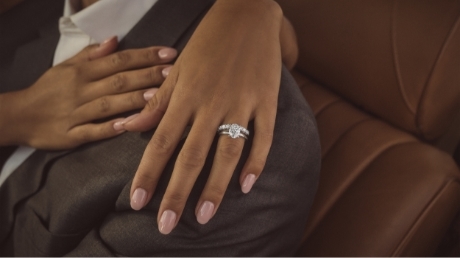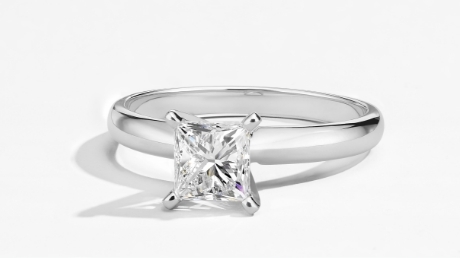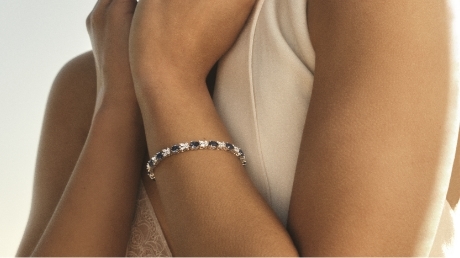A diamond is the world’s most enduring symbol of love. Whether you’re celebrating a milestone anniversary or making an everyday moment sparkle, there are now more ways than ever to find the diamond that tells your unique story. Today, lab-grown diamonds and diamond alternatives are growing in popularity as more affordable options to natural diamonds.
Learn more about how lab-grown diamonds compare to natural diamonds and explore some of the most popular diamond alternatives, so you can find the diamond option that’s right for you.
What Are Lab-Grown Diamonds: Core Differences Between Natural vs. Lab-Grown
Lab-grown diamonds (also referred to as engineered, man-made, or lab-created diamonds) possess the same optical, chemical, and physical properties as a natural diamond. Natural vs. lab-grown diamonds are virtually indistinguishable to the untrained eye. What sets them apart, however, are their origin and the time they took to form.
Natural diamonds are formed over billions of years deep below the earth’s surface, under extreme pressure and high temperature. They rise and become accessible by volcanic eruption.
SHOP NATURAL DIAMONDS
Lab-grown diamonds are produced in a lab within weeks or months, using specialized technology that mimics the extreme heat and pressure of a natural diamond’s growing environment.
SHOP LAB-GROWN DIAMONDS
Comparing Natural vs. Lab-Grown Diamonds
Find out how natural diamonds vs. lab-grown diamonds compare, so you can decide which option is right for you.
| KAY Diamond Comparison | Natural Diamonds | Lab-Grown Diamonds |
|---|---|---|
| Is it a Diamond? | Yes | Yes |
| Primary Chemical Composition | Carbon | Carbon |
| Source | The Earth | A Laboratory |
| Time to Create | 1 to 3 Billion Years | Several Weeks to Months |
| Supply/Rarity | Finite and Rare | Potentially Unlimited |
| Independently Certified | Yes* | Yes* |
| 100% Conflict-Free | Yes | Yes |
| KAY Responsible Sourcing Commitment | Yes | Yes |
| Included in the Lifetime Diamond Commitment | Yes | Yes |
| Eligible for Trade-In | Yes | Yes |
| Price Comparison (of comparable quality and size) | $$$ | $$ |
| *Select styles & carat weights | ||
Shop KAY with Confidence
Whether natural or lab-created, all of our diamonds are 100% conflict-free. Each is transformed by our experts, who map, cut, and polish the diamond from its rough form to bring to life the precious stone’s unique sparkle, fire, and brilliance.
Exploring Diamond Alternatives
While diamond alternatives (also known as diamond simulants) are made to look like the real deal, they have very different chemical and physical properties. As their name implies, simulant diamonds merely imitate the appearance of a diamond, and generally do not possess the same level of brilliance or durability as natural or lab-created diamonds. However, diamond alternatives are an excellent budget-friendly option.
White Sapphire Vs. Diamonds
White sapphire is available in natural and lab-grown varieties. Natural white sapphires are typically more expensive than lab-grown stones, but they can look milkier and have visible inclusions. Lab-grown white sapphires are clearer and more affordable than their natural counterparts. White sapphires are very durable, but they are not nearly as brilliant, fiery, or sparkly as a diamond.
EXPLORE LAB-GROWN WHITE SAPPHIRES
Cubic Zirconia (CZ) Vs. Diamonds
Cubic zirconia is probably the most commonly known diamond alternative. CZ is often found in children’s and costume jewelry, but it is sometimes used in placeholder and lower quality engagement rings. It is an artificially produced version of the element zircon. Colorless CZ is common, but its brilliance is easily diminished when it gets dirty. It weighs almost twice as much as a diamond, and, like moissanite, has a lot of fire. It is often cut with larger facets to make the fire less noticeable, but those large facets can also make it look more artificial. CZ has good hardness, but it scratches more easily than a diamond.
EXPLORE CUBIC ZIRCONIA
Moissanite Vs. Diamonds
Moissanite is a silicon carbide crystal that’s made in a lab. It is extremely hard, but still more likely to scratch than a diamond. It has a lot of fire—a rainbow effect seen when light hits the stone—but moissanite lacks the brilliance and sparkle of a diamond. This rainbow effect can also make it look more artificial. Many moissanites are colorless, but it is more susceptible to color changes from heat. The color likely won’t hold up as well as a diamond over time. KAY does not offer moissanite products at this time.
Frequently Asked Questions
From how they’re made to quality and value, get answers to your most frequently asked questions about lab-grown diamonds here.
Lab-grown diamonds, also known as synthetic diamonds or cultured diamonds, are diamonds that are created in a laboratory setting using advanced technological processes. They have the same chemical composition, crystal structure, and physical properties as natural diamonds.
Generally, lab-grown diamonds are less expensive than natural diamonds of comparable quality and size. The cost savings arise from the lower production costs associated with lab-grown diamonds and the absence of mining-related expenses.
Lab-grown diamonds can be of comparable quality to natural diamonds in terms of color, clarity, cut, and carat weight. They undergo the same grading and certification processes as natural diamonds and can achieve the same standards of excellence.
Lab-grown diamonds are created using two primary methods: High Pressure High Temperature (HPHT) and Chemical Vapor Deposition (CVD). HPHT mimics the conditions found in the Earth's mantle, while CVD involves the deposition of carbon atoms onto a substrate to grow diamond crystals layer by layer.
Lab-created diamonds have the same optical, chemical, and physical properties as a diamond that is grown naturally under the earth's surface. A lab-grown diamond is apprised using the same 4Cs (cut, color, clarity, carat) and can deliver the same fire, scintillation and sparkle as a natural diamond.
Yes, lab-grown diamonds can be certified by independent gemological laboratories using the same grading standards and criteria applied to natural diamonds. Certifications provide assurance of the diamond's quality, authenticity, and origin.
Lab-grown diamonds are often considered more ethical and sustainable than natural diamonds because they do not involve the environmental and social impact of diamond mining. They are produced using renewable energy sources and have a lower carbon footprint compared to mined diamonds.
The main difference between lab-grown diamonds and natural diamonds is their origin. Natural diamonds are formed deep within the Earth's mantle over millions of years through natural geological processes, while lab-grown diamonds are created in a controlled laboratory environment over a shorter period.
Yes, lab-grown diamonds are increasingly popular choices for engagement rings, wedding bands, and fine jewelry pieces. They offer consumers a sustainable and ethical alternative to mined diamonds without compromising on beauty or quality.
Lab-grown diamonds are available from a variety of sources, including jewelry retailers, online stores, and specialized laboratories that produce and sell lab-grown diamonds. It's essential to purchase from reputable vendors who provide certified diamonds and transparent information about the diamond's origin and quality.
Lab-created diamonds have the same optical, chemical and physical properties as natural diamonds. However, because lab-created diamonds can be produced in abundance, they are less expensive and make larger size diamonds more affordable. Their relative abundance may not ensure that the value will hold over time.
Diamond Education from the Experts
Lab-Grown Diamonds
Lab-created diamonds come in a variety of classic and modern shapes and cuts. Explore your options to find a diamond that fits your style.
The Four Cs of A Diamond
Understanding the cut, color, clarity and carat of a diamond can help you choose the one that suits your lifestyle and budget.
Lab-Grown Gemstones
Learn more about lab-grown jewelry and explore KAY’s stunning selection, so you can find the perfect gift!




 They will be on video but won't see you.
They will be on video but won't see you. Make sure to enable your mic if prompted.
Make sure to enable your mic if prompted. Language:
Language:





